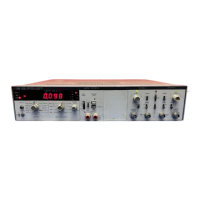Model 5328A
Operation
Table
3-3.
Functions and Resolution Switch Settings
FUNCTION
FREQ A, FREQ C
PERIOD A, T.I. A to
B
PERIOD AVG
A,
T.I. AVG A to
B
DVM
RATIO B/A, RATIO C/A,
DVM/At
START, START CLOCK
EVENTS C, A to
B;
DVM A to Bt
RESOLUTION, N Switch
lndicates frequency resolution in Hz.
lndicates the factor (N) by which time base
is
scaled.
Maximum resolution occurs with
N=l.
lndicates number of time intervals or periods over which
the average measurement is made.
lndicates the integration time (per Table 3-2) for the
measurment.
lndicates the number of counts at the A input over which
the ratio measurement
is
made. Resolution improves with
increasing N.
lndicates scale factor. In START, the frequency at A
is
scaled by N. In START CLOCK, internal oscillator
is
scaled
by N.
Independent of RESOLUTION setting.
lndicates the number of counts at the A input over which
the ratio measurement
is
made. (The DVM circuits are of
the V to
F
type with the factor 10 kHz/volt.) Resolution
improves with increased N. Annunciator
is
not displayed
in units (V) but prefix (m,
p,
n, etc.)
is
displayed.
tUPhantom" functions
3-63.
Input Channel Selection
3-64.
Two separate inputs are provided on the standard universal module. The
A
and B inputs
are identical in specification and identical controls are provided for each input to allow maximum
versatility and accuracy. The COM A-SEP switch, located between the two inputs, controls the
selection of input.
3-65.
In the SEP position, the A and
B
inputs and controls operate independently of each other
for applications in time interval, ratio, or other operations where the signals applied to theA and
B inputs are from different sources.
3-66.
In the COM A position, the input circuits are connected as described in the following
paragraphs. The difference
beteen the standard and Option 040 universal modules
is
shown.
3-67.
STANDARD UNIVERSAL MODULE. In the COM A position, the INPUT B connector
is
disconnected and the A and
B
input amplifiers areconnected togetherto the INPUTA connector
as shown in Figure 3-14. As can be seen from the figure, the channel
B
AC-DC switch and
attenuator control are disabled when the COM A. The channel A AC-DC and attenuation
controls condition the input signal to both channel A and channel B input amplifiers. The
impedance remains 1 MR (although input capacitance increases from 40 pF to approximately 65
pF) and the channel sensitivity, dynamic range, and damage levels remain unchanged.
Artisan Technology Group - Quality Instrumentation ... Guaranteed | (888) 88-SOURCE | www.artisantg.com

